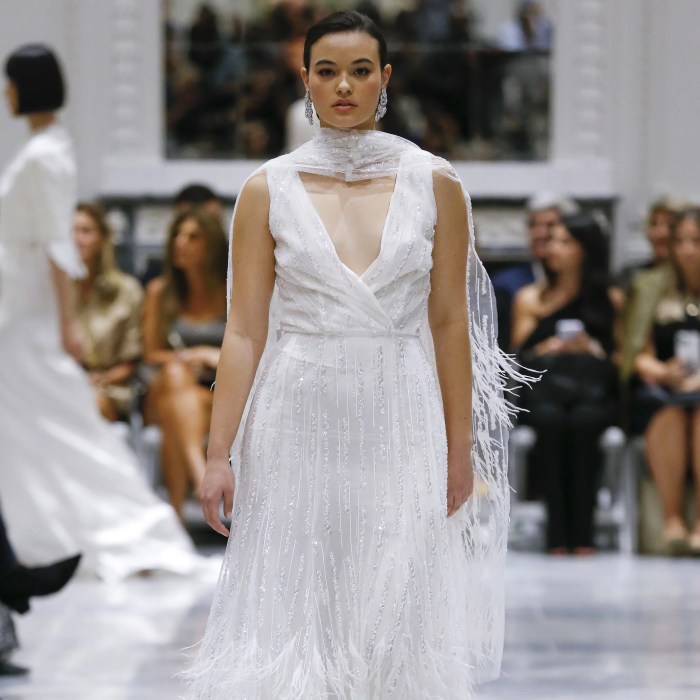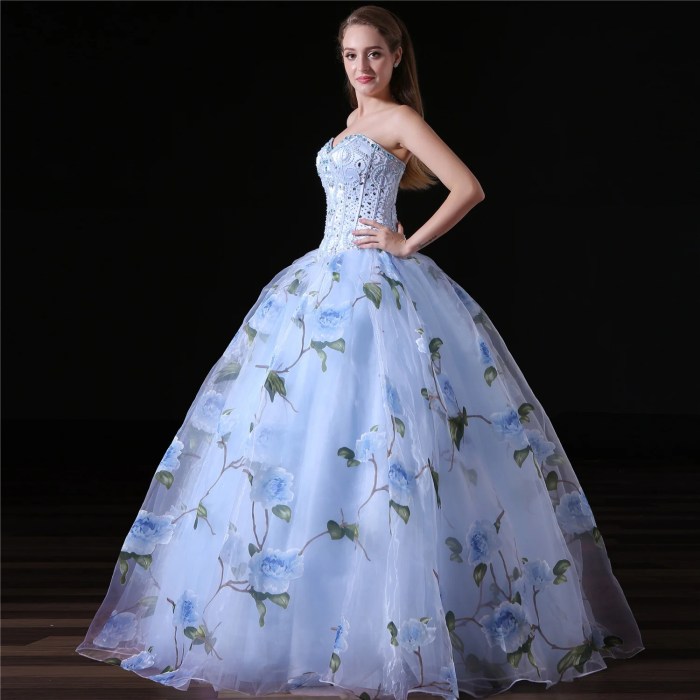A Journey Through Wedding Dress Styles
Wedding dresses and gowns – From the simple linen gowns of ancient times to the elaborate creations of today, the wedding dress has undergone a remarkable evolution, reflecting societal shifts, technological advancements, and evolving aesthetic preferences. This journey explores the captivating history and diverse landscape of wedding dress styles, fabrics, design elements, and the process of selecting the perfect gown for your special day.
Wedding Dress Styles Throughout History
The history of the wedding dress is a fascinating tapestry woven with threads of tradition and innovation. Early wedding gowns were often simple, reflecting the practicality of the time. However, as societal norms evolved, so did the wedding dress, becoming increasingly ornate and symbolic of status and wealth. The Victorian era saw the rise of elaborate lace and embellishments, while the 20th century brought forth a wave of diverse styles, influenced by fashion trends and cultural shifts.
The modern wedding dress market now offers an unparalleled array of choices, catering to every taste and preference.
Neckline Variations: A Comparison
The neckline plays a crucial role in defining the overall aesthetic of a wedding dress. A sweetheart neckline, with its heart-shaped curve, offers a romantic and flattering silhouette, while a V-neck creates a lengthening effect, emphasizing the collarbone and drawing attention upwards. A halter neckline, with its straps that tie around the neck, provides a sleek and sophisticated look, perfect for a modern or minimalist style.
The choice of neckline should complement the bride’s body type and personal style.
Silhouette Styles: Exploring the Options
The silhouette of a wedding dress significantly impacts its overall appearance. The classic A-line silhouette, with its fitted bodice and gradually widening skirt, is universally flattering and timeless. The ballgown, characterized by a full, voluminous skirt, exudes elegance and grandeur, perfect for a formal affair. The mermaid silhouette, with its close-fitting bodice and flared skirt starting at the knees, accentuates the curves and creates a dramatic effect.
Choosing the right silhouette depends on the bride’s figure and the desired level of formality.
Fabric Choices: Impact on the Dress
The fabric of a wedding dress profoundly affects its look, feel, and drape. The choice of fabric influences everything from the overall silhouette to the level of formality and the season in which the dress is most suitable. Lightweight fabrics like chiffon and organza create a flowy and ethereal look, while heavier fabrics like satin and brocade offer a more structured and luxurious feel.
Popular Wedding Dress Fabrics
| Fabric Type | Texture | Drape | Suitability for Seasons |
|---|---|---|---|
| Silk | Smooth, luxurious | Fluid, elegant | Spring, Summer, Autumn |
| Satin | Smooth, shiny | Fluid, elegant | Spring, Summer, Autumn |
| Lace | Delicate, intricate | Depending on type; can be stiff or soft | All Seasons |
| Tulle | Lightweight, sheer | Flowy, ethereal | Spring, Summer, Autumn |
Wedding Gown Fabrics and Materials: A Deeper Dive

Source: popsugar-assets.com
The selection of fabrics and materials significantly impacts the overall aesthetic, comfort, and cost of a wedding gown. Understanding the properties of different fabrics and their suitability for various styles and seasons is crucial in the dress selection process.
Lace: Types and Characteristics
Lace, a timeless element in wedding gowns, comes in a vast array of types, each with its unique texture and pattern. Chantilly lace, known for its delicate floral patterns, is often used for overlays and accents. Alençon lace, with its intricate geometric designs, offers a more structured and formal look. Venetian lace, characterized by its heavier weight and bold patterns, creates a luxurious and dramatic effect.
The choice of lace type depends on the desired level of detail and formality.
Silk, Satin, and Organza: A Comparison
Silk, known for its luxurious sheen and smooth drape, is a classic choice for wedding gowns. Satin, with its high luster and smooth surface, offers a more modern and sleek aesthetic. Organza, a sheer and crisp fabric, creates a delicate and ethereal look, often used for overlays or accents. The choice among these fabrics depends on the desired level of sheen, weight, and formality.
Beaded and Embroidered Fabrics: Advantages and Disadvantages
Beaded and embroidered fabrics add a touch of opulence and intricate detail to a wedding gown. However, these embellishments can increase the cost and weight of the dress. While they offer a luxurious and glamorous look, they also require more delicate care and cleaning.
Fabric Choice and Cost
The cost of a wedding gown is significantly influenced by the choice of fabrics. Luxurious fabrics like silk and hand-embroidered lace tend to be more expensive than synthetic alternatives. Understanding the cost implications of different fabrics is essential in setting a realistic budget.
Sustainable and Eco-Friendly Fabric Options, Wedding dresses and gowns
Increasingly, brides are seeking sustainable and eco-friendly options for their wedding dresses. Organic cotton, hemp, and recycled fabrics are becoming more prevalent, offering a responsible and ethical choice. These fabrics often have a softer texture and a more natural look.
- Organic cotton
- Hemp
- Recycled fabrics
- Tencel
- Peace silk
Design Elements: Shaping the Wedding Dress Aesthetic
Beyond the fabric and silhouette, various design elements contribute to the overall aesthetic of a wedding dress. These details, from embellishments to sleeve styles, play a crucial role in creating a unique and personalized look.
Embellishments: Beading, Embroidery, and Appliqués
Beading, embroidery, and appliqués add intricate detail and texture to a wedding gown. Beading can create shimmering effects, while embroidery adds delicate patterns and designs. Appliqués, often made of lace or other fabrics, can create focal points or add a three-dimensional element. The choice of embellishments depends on the desired level of detail and the overall style of the dress.
Sleeve Length and Style: Impact on the Aesthetic
Sleeve length and style significantly impact the overall look of a wedding dress. Sleeveless gowns offer a classic and elegant look, while long sleeves add a touch of sophistication and drama. Different sleeve styles, such as bell sleeves, puff sleeves, or cap sleeves, create distinct aesthetics, complementing various body types and styles.
Innovative Design Features in Modern Wedding Dresses
Modern wedding dress designers are constantly pushing boundaries, incorporating innovative design features such as unconventional necklines, asymmetrical cuts, and unique back details. These features allow brides to express their individuality and create a truly personalized look. Examples include dresses with detachable skirts or trains, allowing for a transformation during the reception.
Train Length: Shaping the Silhouette and Drama
The train length of a wedding dress contributes significantly to its overall drama and silhouette. A chapel-length train extends to the floor, trailing behind the bride. A cathedral-length train is longer, often extending several feet behind. A court train falls midway between the chapel and cathedral lengths. The choice of train length should be considered in relation to the venue and the desired level of formality.
Train Length and Venue Suitability
| Train Length | Description | Venue Suitability | Wedding Style Suitability |
|---|---|---|---|
| Chapel | Extends to the floor, trailing behind the bride | Most venues | Formal, semi-formal |
| Cathedral | Extends several feet behind the bride | Larger venues, outdoor settings | Formal, grand |
| Court | Midway between chapel and cathedral | Most venues | Formal, semi-formal |
Wedding Dress Shopping and Selection: A Step-by-Step Guide
Finding the perfect wedding dress is a journey that requires careful planning and consideration. This guide provides a step-by-step approach to ensure a smooth and enjoyable experience.
Finding the Perfect Wedding Dress
Begin by researching different styles and designers to identify your preferences. Consider your body type, personal style, and the overall theme of your wedding. Set a realistic budget and schedule appointments at bridal shops and boutiques.
Body Type and Personal Style Considerations
Consider your body type and personal style when selecting a dress. Choose a silhouette and neckline that flatter your figure and reflect your personality. Don’t be afraid to experiment with different styles and find what makes you feel confident and beautiful.
Alterations and Fittings
After selecting your dress, schedule alterations and fittings with a professional seamstress. Alterations ensure a perfect fit and enhance the overall look of the dress. Attend multiple fittings to ensure the dress fits comfortably and beautifully.
Budgeting and Cost Management
Set a realistic budget for your wedding dress, including the cost of the dress itself, alterations, and accessories. Shop around and compare prices before making a purchase. Consider purchasing a sample dress or a used gown to save money.
Questions to Ask Bridal Shops and Designers

Source: isueer.com
Prepare a list of questions to ask bridal shops and designers to ensure you are making an informed decision. Inquire about their experience, their selection of dresses, their pricing policies, and their alteration services.
- What is your experience with wedding dress alterations?
- What is your return policy?
- What is included in the price of the dress?
- What is your turnaround time for alterations?
- Can I bring my own seamstress for alterations?
Illustrative Examples of Wedding Gowns
To further illustrate the diversity of wedding dress styles, here are detailed descriptions of three distinct gown types.
Classic Ballgown Wedding Dress
Imagine a breathtaking ballgown crafted from luxurious ivory silk satin. The bodice, fitted and structured, features delicate hand-beaded lace appliqués that cascade down the shoulders and onto the fitted bodice. The full, voluminous skirt, made from layers of silk tulle, creates a princess-like silhouette. A long cathedral-length train adds a touch of regal drama, flowing elegantly behind the bride as she walks.
The overall effect is one of timeless elegance and refined glamour.
Modern Minimalist Wedding Dress
Envision a sleek and sophisticated minimalist gown made from flowing crepe fabric. The bodice is simple and understated, with a clean V-neckline and thin straps. The skirt is fitted and flows gracefully to the floor, creating a streamlined silhouette. Minimalist embellishments, such as delicate pearl buttons down the back or a subtle sash at the waist, add a touch of elegance without overpowering the simplicity of the design.
This dress is the epitome of understated chic.
Bohemian-Style Wedding Dress
Picture a bohemian-inspired gown made from soft, flowing lace. The bodice is loosely fitted, featuring delicate lace detailing and perhaps a plunging neckline. The skirt is tiered and layered, creating a romantic and whimsical look. The lace is accented with subtle embroidery or appliqués, adding a touch of texture and visual interest. The dress may feature long, flowing sleeves or a relaxed, off-the-shoulder neckline.
This style exudes effortless beauty and free-spirited charm.
General Inquiries: Wedding Dresses And Gowns
How far in advance should I start shopping for my wedding dress?
Ideally, start browsing 9-12 months before your wedding to allow ample time for alterations and potential delays.
What should I wear to my dress appointments?
Wear comfortable undergarments similar to what you’d wear under your dress (e.g., a strapless bra) and nude-toned heels if you plan on wearing them. Keep accessories minimal.
How much should I budget for alterations?
Allocate around 10-15% of your dress cost for alterations. This can vary depending on the extent of adjustments needed.
Can I take photos and videos during my dress appointments?
It’s best to check the bridal shop’s policy beforehand, as some may have restrictions on photography.
What if I change my mind after ordering my dress?
Shop policies vary, but many have cancellation or alteration fees. Carefully review the contract before signing.
